Two kingfishers affected by oil spill recovering well, to spend more weeks under care
One kingfisher is at the National Parks Board’s Centre for Wildlife Rehabilitation, while another is being taken care of by the Animal Concerns Research and Education Society.
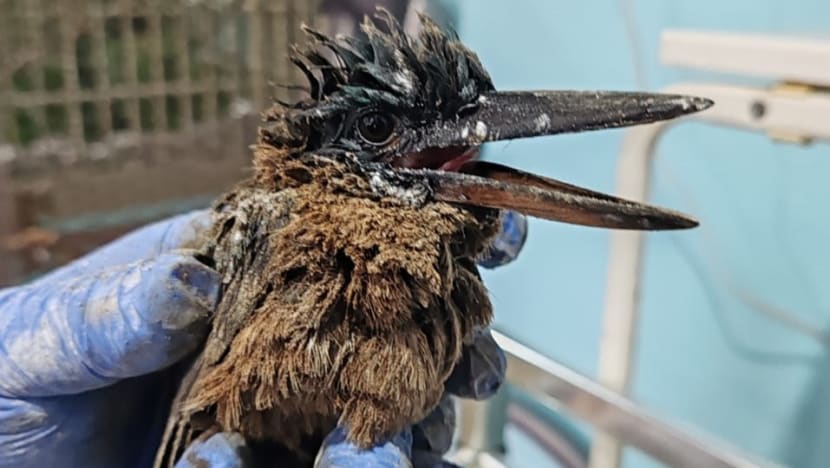
A kingfisher affected by the oil spill is cleaned by veterinary personnel. Acres says the bird is recovering well. (Photo: Acres)

This audio is generated by an AI tool.
SINGAPORE: Two kingfishers affected by the oil spill in Singapore’s waters are recovering well, but are not out of the woods yet, said agencies providing care for the birds.
One is at the National Parks Board’s (NParks) Centre for Wildlife Rehabilitation, while another is being taken care of by the Animal Concerns Research and Education Society (Acres).
It could take at least seven weeks for the oil-slicked birds to be nursed back to health, said National Development Minister Desmond Lee on Wednesday (Jun 26).
KINGFISHER AT NPARKS
When NParks rescued one of the kingfishers at East Coast Park on Jun 16, two days after the oil spill, it was in poor shape.
After daily medication and care at the rehabilitation centre, it is now alert, eating well on its own, and has even gained weight.
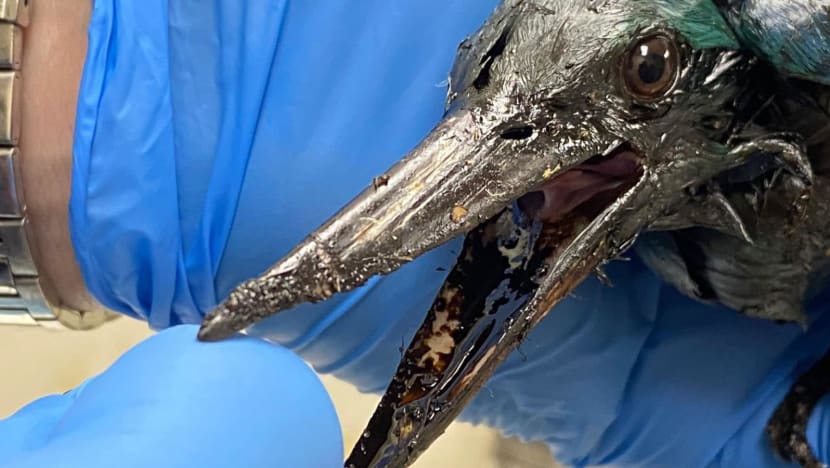
“When it came in, we let it rest first then after that we gave it subcutaneous fluids for hydration, and also a liquid diet,” said NPark’s group director Dr Anna Wong.
However, the kingfisher can only be completely cleaned of oil when it is fully stabilised, as wild birds are easily stressed when handled.
“Slowly, we will clean the oil away. But of course, we will always monitor to make sure that it is not stressed (when) we do it,” said Dr Wong.
Mr Lee said in a Facebook post that the kingfisher is being kept in an incubator with a controlled temperature.
It is being monitored carefully as birds affected by oil spills often suffer from anaemia, a condition where there are low levels of healthy red blood cells to carry oxygen throughout the body.
He added that veterinary personnel have been delicately cleaning the kingfisher, starting with the crucial parts of its body such as the eyes and the beak, to prevent further oil ingestion and irritation.
The oil is removed by carefully washing the feathers and affected areas with an appropriate detergent and warm water.
KINGFISHER AT ACRES
Over at Acres, the kingfisher under its care is also making good progress. It was found on Jun 17 at Lazarus Island.
“We've been taking the cleaning in phases and currently, there's no more oil on the bird and it's able to fly,” said Mr Kalai Vanan, co-CEO of the non-profit animal protection charity.
It took at least five sessions over several days to clean the bird completely, with special attention given to ensure that traces of oil were removed from the feather follicles, especially at its wings.
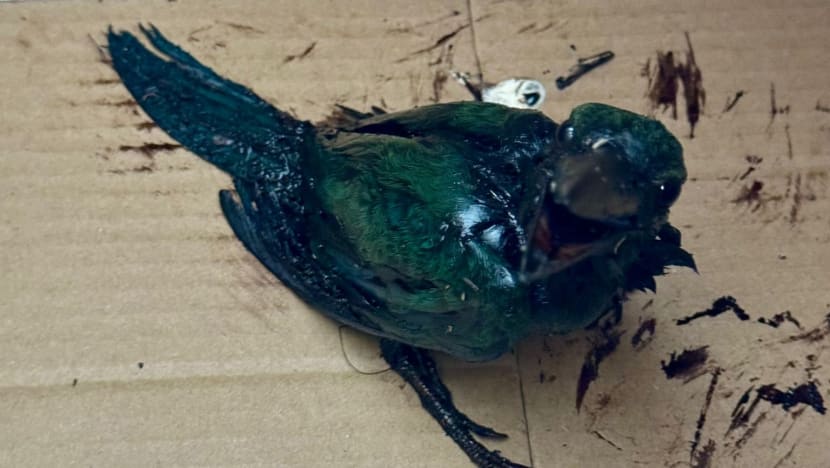
The kingfisher is now housed in a 1m by 1m cage that is 2m tall.
In about a week, it will be moved to a much bigger cage – 4m by 4m wide and 2m tall– so it can practise flying longer distances.
However, the charity still puts its survival rate at about 50 per cent, as kingfishers do not thrive well in captivity.
“Because it’s in a cage, stress is still involved. Kingfishers don’t like to be handled too much. We are limiting the care to a few staff only … and trying to stay away from the cage as much as possible,” Mr Kalai said.
“Now, it's about monitoring it further. We need to give some time for this bird to regain its natural oil on its feathers – its waterproofing abilities.”
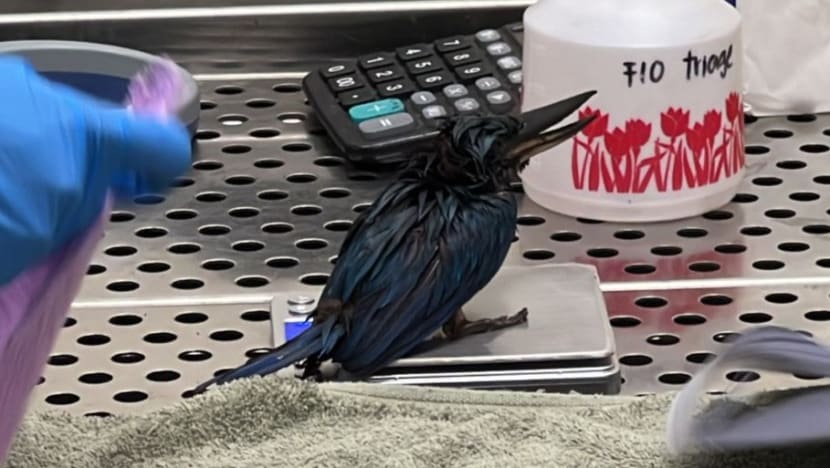
The cleaning process inevitably removes natural oil on feathers. The natural oil helps to ensure that birds’ feathers repel water – critical especially for kingfishers which dive into water to catch fish.
Depending on its recovery, Acres expects to release the kingfisher back into the wild in one to two months.
TWO OTHER KINGFISHERS HAVE DIED
Four kingfishers have been retrieved from the oil spill so far but two have died.
Acres said one of the kingfishers, rescued from the Keppel area, died about 36 hours after being found.
“An autopsy revealed it died from dehydration and kidney issues, which could have been a result of ingesting the oil,” said Mr Kalai.
He said birds are usually the most impacted victims of oil spills as the oil clinging to their feathers could impair their ability to fly.
He added that while oil spills are rare in Singapore, birds are commonly caught by glue traps meant for rats.
“Glue trapped birds are something we handle almost daily, and we tweak the process to help the oil-spill victims,” he said.
IMPACT ON WILDLIFE UNCLEAR
The oil spill occurred on Jun 14 when a dredger struck a stationary bunker vessel and ruptured an oil tank at Pasir Panjang Terminal.
NParks said it is still too early to do a scientific assessment on the impact on wildlife so far.
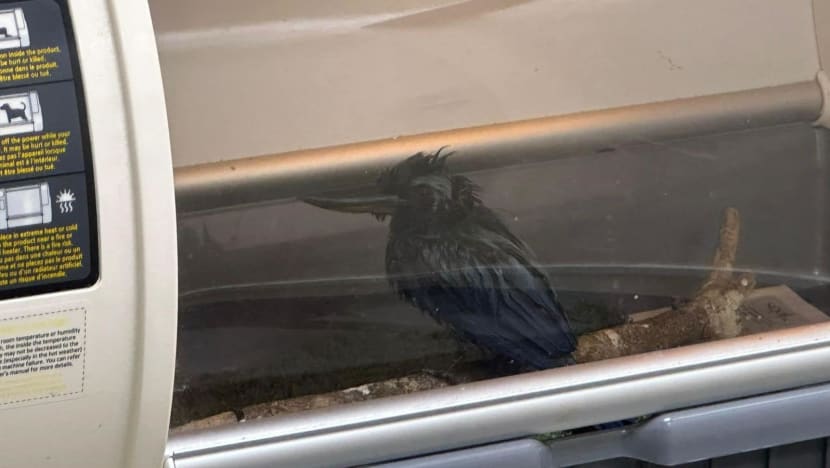
Concerns come especially as the oil slick has spread, including to the Southern Islands which teem with wildlife.
Mr Kalai said there have been reported sightings of otters and monitor lizards affected by the oil spill but they have evaded capture.
“We don't yet know the effects on animals under the water. Many animals share the straits, from dolphins to otters to dugongs and sea turtles … and also other marine life such as coral reefs, crab and fish,” he said.
Minister Lee said that apart from NPark and Acres, the Mandai Wildlife Group, SEA Aquarium, and Singapore Veterinary Association are ready to carry out wildlife rescue and care, if reports of animals impacted by the oil slick surface.
Authorities said that members of the public who encounter wildlife that have come into contact with the oil spill should not attempt to rescue, capture or clean the animals. Instead, they should contact NParks or Acres via their hotlines.


















